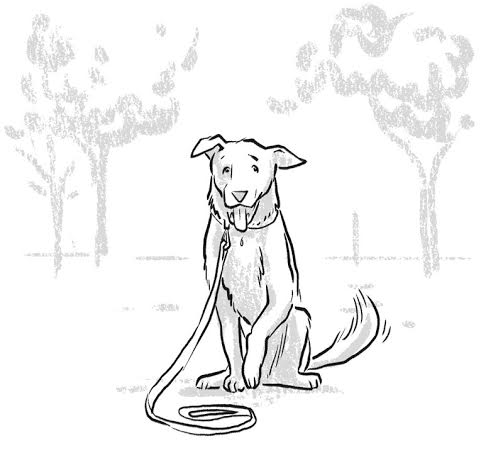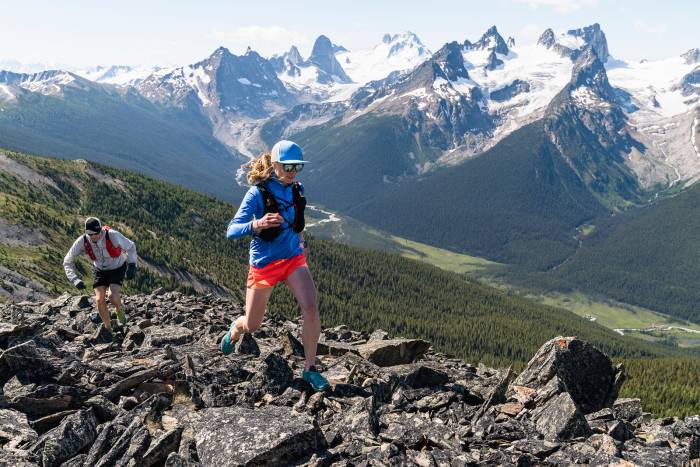A book by Lisa Jhung — Trailhead: The Dirt On All Things Trail Running — covers the activity of off-road running. This post, ‘Running With Dogs,’ is excerpted from the book, published by VeloPress.
Running With Dogs
If you run with a dog, you already know the rewards. If you never have, you should experience it at least once. Consider borrowing a dog from a friend.
Benefits of running with dogs:
- Added safety
- A running partner who goes where, when, and at what pace you want
- Motivation to get out and run . . . dogs need exercise
- A joyful companion
- Dog smiles rub off on humans

What to bring when running with a dog
A leash. Whether the trail allows dogs off leash or not, it’s advisable to have a leash with you. There may be times when you need to put the dog on a leash, if only for a short while—for example, you need to keep your dog from chasing a pack of deer; someone on the trail near you is afraid of dogs; you don’t want your dog jumping in a pond of stagnant water.
A poop bag. It’s simple common courtesy—and sometimes the law—to pick up after your dog. It is also a health issue, as poop spreads disease and contaminates water. Always have a poop bag on you. Tying a plastic bag around your leash ensures that you always have a bag on you.
Harness. If your dog pulls excessively on the leash when you run together, consider using a harness to minimize tracheal irritation—hers from pulling while wearing a regular collar, and yours from yelling.
Extra water. If you run with a water bottle or hydration bladder, teach your dog to lick the stream of water like it’s coming out of a hose, and bring extra water for your dog to drink. If your dog won’t drink this way, carry a collapsible fabric bowl or try squirting water into your cupped hand for him to drink.
A towel. Trails can be muddy and dusty, and they often have creeks or ponds nearby that are irresistible to your dog. Having a towel in your car allows you to wipe down your dog or cover your seats to protect your car from grime.
Know The Rules
It’s important to know the dog-related rules on the trails where you plan to run. Some trails allow dogs on leash. Some allow dogs that are voice-controlled and not on a leash, and a voice-controlled dog might have to wear a colored tag on its collar that proves that the owner went through the proper voice-control procedures for your area. Some trails, such as those in many national parks, don’t allow dogs.
IS THERE A POOP FAIRY?
When a dog owner has a bag, scoops up his or her dog’s poop, and leaves the full bag on the side of the trail, he or she is probably planning to pick up the bag on the way back to the trailhead (rather than run the entire trail carrying a bag of poop). When dog owners do not pick up the bags they left, for whatever reason, it’s possible that they believe a magical poop fairy will flutter by to pick it up.
There is no such thing as a poop fairy. Pick up your dog’s poop, and dispose of the bags.
Special Canine Considerations
Know your dog. Even if you have great faith in your dog’s ability to run long distances at high speeds, err on the side of caution. The dog’s health depends on you not running him too much, too fast. Dogs will rarely let you know that they’re too tired. They want to keep going with you, and they will try even if it’s too much for them. Talk to your veterinarian about what is appropriate for your dog’s breed, age, and personality.
Know the trails. Choosing trails wisely can make a difference in both your and your dog’s experience. Running technical or hilly trails slows you down, which is a good thing for your pup because it makes the pace more manageable.
Watch the heat. Heat exhaustion and heatstroke affect dogs more than humans. While humans sweat to regulate their body temperatures, dogs do not. Dogs pant to cool off but can suffer from problems caused by heat. In hot weather, plan to run near a creek or other natural water source so your pup can cool off, and seek out trails with a lot of shade.
Know the flora. Certain parts of the natural world should be avoided when running on a trail with your dog. Oils from poison oak, poison ivy, and sumac can get on your dog’s fur and then be spread throughout your home and among your family. If you know your dog ran through any of these plants, wash her with an oil-removing soap, as you would yourself.
Respect the fauna. Keep your dog from terrorizing wild animals—except possibly squirrels who may have eaten the tomatoes out of your garden.
Watch out for ride-alongs. Running in the wild with your dog exposes her to prickers, burrs, and ticks. Check your dog’s fur after running in areas rife with any of the above, and remove any you find.
Prepare for cold and snow. If you run on a snowy trail and your dog starts limping or whining, check his paws for ice balls. Remove promptly. In bad weather, consider covering the dog’s paws with booties, which may be found at pet stores or online. (Know that some dogs will refuse to wear booties, gnawing at them and shaking them off until you resign yourself to losing the money you spent.) Running with a young dog whose joints and bones haven’t fully developed can cause issues such as arthritis in your pup. Talk to your vet about your puppy’s appropriate running age.
–Adapted with permission of VeloPress from “Trailhead: The Dirt on All Things Trail Running” by Lisa Jhung, with illustrations by Charlie Layton. For more, visit velopress.com/trail.










